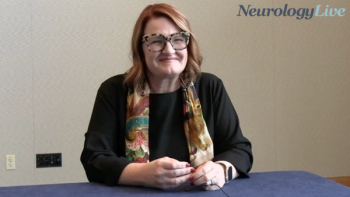
Cala Trio Neuromodulation Device Effectively Reduces Symptoms in Essential Tremor
After wearing the noninvasive device, 62% of TETRAS-rated patients and 68% of BF-ADL-rated patients whose tremors were rated as "severe" or "moderate" improved to "mild" or "slight" scores.
Renee Ryan
New study results suggest that non-invasive neuromodulation therapy with the Cala Trio device can safely and effectively reduce hand tremor over the course of 3 months in in patients with essential tremor (ET).
The co-primary end points of the study—improvements on clinician-rated Tremor Research Group Essential Tremor Rating Assessment Scale (TETRAS) and patient-rated Bain & Findley Activities of Daily Living (BF-ADL) dominant hand scores—were both met with significance (P <.0001). All told, 62% (TETRAS) and 68% (BF-ADL) of ‘severe’ or ‘moderate’ patients improved to ‘mild’ or ‘slight’ hand scores.1
Patients treated with the device showed improvement in TETRAS and BF-ADL from pre- to post-stimulation at each in-clinic visit point (P <.0001 for all 6 pairs of visits and measurements). Pre-stimulation tremor level also improved from Visit 1 to Visit 3 on both measurements (P <.0001 for both).
"ET is one of the most common movement disorders among adults. It can be physically and psychologically draining while reducing the quality of life for these patients," said Renee Ryan, chief executive officer, Cala Health, in a statement.2 "The PROSPECT study publication confirms that Cala Trio therapy is a safe and effective treatment option and, most importantly, shows the improved quality of life for these ET patients. These findings, consistent with those demonstrated in previous trials against sham, will be leveraged to support our reimbursement initiatives, leading to improved access for patients living with essential tremor."
In total, 205 patients completed the study, 193 of which underwent 21,806 valid TAPS therapy sessions that included the device electrically stimulating the median and radial nerves for 40 minutes with an alternating bursting pattern tuned to the frequency of each patient’s tremor.
The TETRAS scores, consisting of 6 measurements, were classified consistently with the 0- to 4-point scale as either ‘no tremor’ (defined as total score of 0), ‘slight’ (score of 1—6), ‘mild’ (score of 7–12), ‘moderate’ (score of 13–18), or ‘severe’ (score of 19–24). Likewise, the BF-ADL scores, consisting of 8 measurements, were classified as either ‘no tremor’ (total score of 8), ‘mild’ (score of 9–16), ‘moderate’ (score of 17–24), or ‘severe’ (score of 25–32). In total, under TETRAS and BF-ADL definitions, the patients at baseline consisted of severe (TETRAS: n = 8; BF-ADL: n = 14), moderate (TETRAS: n = 93; BF-ADL: n = 119), mild (TETRAS: n = 103; BF-ADL: n = 72), and slight (TETRAS: n = 1) ratings.
Additional end points included the Clinical and Patient Global Impression of Improvement (CGI-I and PGI-I, respectively) scores. On the CGI-I, clinicians reported improvement at a rate of 68%, while 60% of patients reported improvement on the PGI-I. The Quality of Life in Essential Tremor Questionnaire (QUEST) results also improved from baseline (P = .0019).
Wrist-worn accelerometer recordings before and after 21,806 therapy sessions showed that 92% of patients improved, and 54% of patients experienced ≥50% improvement in tremor power.
Device-related adverse events (AEs) such as wrist discomfort, skin irritation, or pain, occurred in 18% of patients. No device-related serious AEs were reported. Discontinuations from the study included withdrawal of consent (n = 27), AEs (n = 8), investigator decision (n = 1), failure to complete Visit 3 procedures (n = 9), and other reasons (n = 13). Reasons cited for withdrawal from the study included time commitment, lack of benefit, device malfunctions, fear of AE reoccurrence, falling out of eligibility criteria, dislike of stimulation sensation, and other or unspecified reasons.
REFERENCES
1. Isaacson SH, Peckham E, Tse W, et al. Prospective Home-use Study on Non-invasive Neuromodulation Therapy for Essential Tremor. Tremor. 2020;10:29. doi: 10.5334/tohm.59.
2. Cala Health Announces Continued Growth and Momentum with Clinical, Product Development, and Management Milestones to Support Cala Trio Therapy for the Treatment of Essential Tremor. News release. Burlingame, CA. Cala Health. Published August 17, 2020. Accessed August 27, 2020. https://www.businesswire.com/news/home/20200817005345/en/Cala-Health-Announces-Continued-Growth-Momentum-Clinical
Newsletter
Keep your finger on the pulse of neurology—subscribe to NeurologyLive for expert interviews, new data, and breakthrough treatment updates.


































